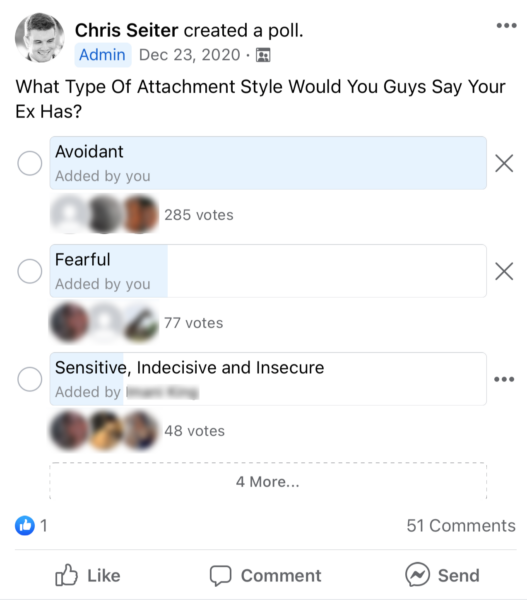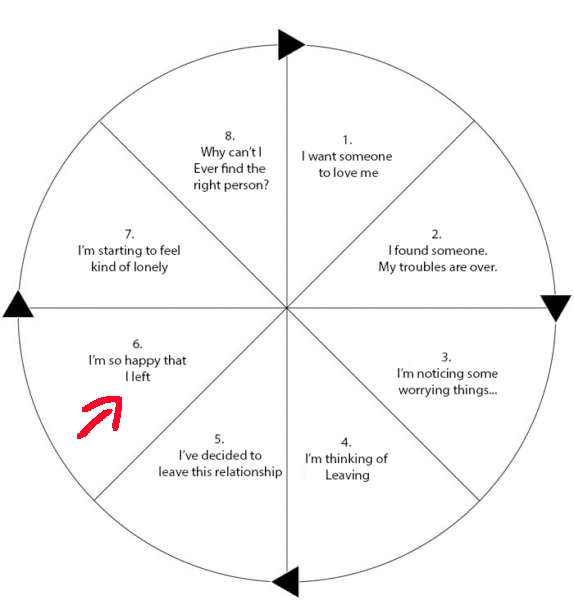Today we’re going to talk about if breakups tend to hit guys later in the post breakup process.
It’s been my experience that in general guys do tend to feel the effects of a breakup later than women. In fact, some new research has suggested that initially women will feel the effects of a breakup worse at first. However, they tend to recover more fully while men don’t.
Side Note: This article is actually a continuation on my “guys processing breakups” series. Check out the first in that series.
In this article I’d really like to dive in to the reasons that I believe men will experience a breakup later than women.
Namely to talk about the following things,
- The Binghamton University Study And It’s Relation To When Breakups Hit Guys
- Our Internal Research On Men And Their Connection To Avoidants
- How The No Contact Rule Can Help Us Understand How Men Process Grief
Let’s begin!

What Are Your Chances of Getting Your Ex Boyfriend Back?
Take the quizLooking At The Binghamton University Study And When Breakups Hit Guts
If you aren’t familiar with the way we roll here at Ex Boyfriend Recovery. Our theory is that if we can’t prove the effectiveness of something we talk about or say then we aren’t going to recommend it to our clients. How do we prove an ideas effectiveness?
With two core tenets,
- Our internal research is telling us
- We’ve found legitimate literature backing up our hypothesis
And it just so happens that when it comes to understanding when breakups hit guys the most legitimate research we could find was a study done by Binghamton University called, Women hurt more by breakups but recover more fully.
So, essentially this study backs up my hypothesis that men have more difficulty recovering from breakups than women.
In fact, I found this quote particularly interesting,
Researchers from Binghamton University and University College London asked 5,705 participants in 96 countries to rate the emotional and physical pain of a breakup on a scale of one (none) to 10 (unbearable). They found that women tend to be more negatively affected by breakups, reporting higher levels of both physical and emotional pain. Women averaged 6.84 in terms of emotional anguish versus 6.58 in men. In terms of physical pain, women averaged 4.21 versus men’s 3.75. While breakups hit women the hardest emotionally and physically, women tend to recover more fully and come out emotionally stronger. Men, on the other hand, never fully recover — they simply move on.
But what does that mean?
Men simply move on but never fully recover.
Perhaps looking at how avoidant individuals process trauma can explain this phenomenon.
Men And Their Connection To Avoidant Attachment Style
In 2020 I really started putting my foot forward on researching attachment styles.
In fact, in asking our clients how many of their boyfriends were avoidant I got the following results back,
So, the vast majority of our clients are going through breakups with avoidant men but what does that mean?
A few days ago I wrote an article called The Definitive Guide To Male Psychology. In it, I refer to the three core concepts that pretty much describe an avoidant.
- They struggle in moments with being vulnerable and sharing feelings
- They criticize others who are vulnerable and feel an internal shame because they themselves struggle with vulnerability
- They are very big on independent behavior and self sufficiency (big shocker here)
Every avoidant has what we call a core wound. Something that harkens back to their childhood that can set them off. The core wound in and of itself is usually responsible for “triggering” their avoidant side.
For an avoidant their core wound is any type of threat to their independence.
But that’s not necessarily helpful for explaining why breakups “hit” guys later. What’s more helpful is to actually look at how avoidants handle breakups. Like literally taking a look at their coping behaviors during the post breakup period.
The Separation Elation To Depression Period
My go to when looking at avoidants is a website called Free To Attach which specializes in picking apart every aspect of avoidants in relationships.

What Are Your Chances of Getting Your Ex Boyfriend Back?
Take the quiz- How they act during a relationship
- How they act during a breakup
- How they act after a breakup
- You get the idea
Through that website I’ve actually been able to learn more about avoidants than I have through pouring through countless “reputable studies.”
Anyways, what’s fascinating about avoidants is that initially after a breakup they go through what’s called a separation elation period.
Pulling directly from Free To Attach,
After a relationship ends, people with an avoidant attachment style tend not to show much anxiety or distress, often feeling an initial sense of relief at the relinquishing of obligations and the sense that they are regaining their self-identity, and not tending to initially miss their partner – this is “separation elation” as the pressure to connect is gone.
For those familiar with my “avoidant relationship death wheel” that would be this part right here,
But it’s a trick. A coping mechanism to stave off the inevitable grief.
And grief is coming.
Once again pulling from Free To Attach,
But they can have a depressive episode from 2-4 months after a breakup, manifested in feeling numb, disconnected and meaningless, which they may try to repress. Everybody needs deeper connection, but often avoidants don’t recognise they need their partners until the partner actually loses interest and leaves, through separation, divorce, also death, illness, or something else.
The toll has come. Their repression no longer working they enter into the “feel sorry for themselves” phase.
What’s perhaps most ironic about it is that in 90% of the cases the avoidant is the one to initiate the breakup. This means that they paint themselves as a victim as opposed to taking ownership for a problem that they themselves usually create.
But it’s all part of their processing of grief. It’s a lot easier to demonize you as opposed to have a hard look in the mirror.
All in all though I’m going to point to that depressive episode roughly 2-4 months as evidence that breakups tend to hit a bit later for men. Remember, most of our clients have avoidant ex boyfriends.
But that’s not the only thing I think can prove the point that men experience breakups later than women.
The Interesting No Contact Rule Finding And How It Can Help Prove My Point
We are pretty big fans of the no contact rule.
However, our version of no contact differs from almost every other version of no contact that you’ll see out there.
Why?
Well, namely we actually want you to use the time away from your ex to move on from them. Yep, we’ve actually seen more success from our clients who used no contact to get over their ex as opposed to those who used it to make their ex miss them.
We call this our “moving on without moving on” mentality.
Essentially we want you to get into the mindset of moving on with the knowledge that down the road you may potentially re-visit your ex
But this is all besides the point.
In researching the no contact rule we learned something really interesting in 2020. There’s a type of time dilation that exists. If you aren’t familiar with time dilation then I suggest you watch the movie Interstellar. Specifically this scene,
To set it up there are some space explorers that want to visit a foreign planet but doing so will have a cost. For every hour they spend on the planet, seven years will pass on earth. Pretty wild, right?

What Are Your Chances of Getting Your Ex Boyfriend Back?
Take the quizEssentially time dilation is all about the human perception of time and what the no contact rule has taught us is that the way we experience time in the post breakup period is different for every individual. Well, specifically they way we experience time during a no contact rule is particularly interesting to pay attention to.
We’ve actually found a correlation between attachment styles and time dilation.
There are really three types of attachment styles that apply to this practice.
- Secure Attachments
- Avoidant Attachments
- Anxious Attachments
In general the average no contact rule for our client usually is around 30 days but how each attachment style experiences these 30 days is different.
- For a secure person 30 days will feel like 30 days
- For an avoidant person 30 days will feel like 15 days
- For an anxious person 30 days will feel like 45 days
So, what does this tell us?
That time is experienced differently based on your state of mind. An anxious person is obsessing about their ex 24/7. While an avoidant person is repressing their ex. That repression from an ex is key to proving the point that guys experience breakups later.
It’s all connected to the attachment theory which is really crazy. As you can imagine, many of our clients who have avoidant exes have to take what I’m saying on faith and it’s hard to do especially when you consider their anxious attachment style.
But those that do take what I’m saying on faith. Those that do use their time wisely post breakup tend to see some pretty great results.


Sonia
June 19, 2024 at 8:38 pm
I listen to you whilst working. My work allows me to listen to anything and everything/ but your stuff helped me through the worse / sick/ disgusting bits –
But it’s strange now- 3 weeks later – my physiology has changed- I am still listening on/off to your podcasts, yet, my phone checking for my previous partner is no longer there/ my co- dependency was interrupting my livelihood/ my finances, & how I even tried to like myself in the mirror- I broke it off with my ex because he NEVER tried ANYTHING- I INITIATED EVERYTHING- even to the point of trying to get back together/ I only came to my proper senses surrounded by a scattered bottle of Pringles emulsified to my bed/ my diary/ / my phone cables sprawled across me- a half bottle of shitty red wine to my left-
I just decided No More –